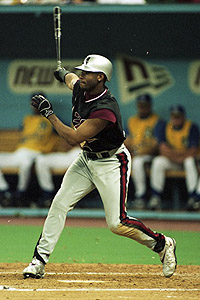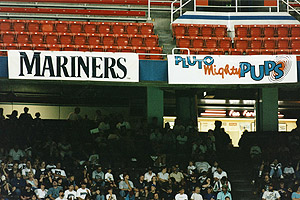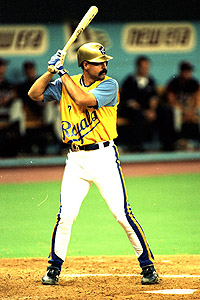In sports, there are moments when time stands still. And thanks to throwback uniforms, there are plenty of junctures where time appears to turn backward. But it's rare when time jumps ahead.

That photo, of course, is from MLB's now-infamous "Turn Ahead the Clock" promotion, which featured 20 big league teams dressed like total freakin' clowns wearing "futuristic" jerseys over the course of 14 games during the summer of 1999. The uniforms were roundly ridiculed at the time, have been ridiculed ever since, and will likely continue to be ridiculed long past the year 2021, which is the year they supposedly represented (a year chosen because the series was sponsored by Century 21, adding the stench of corporate advertising to an already noxious initiative).
But here's something most people don't realize: The 1999 futuristic series, which stretched out from late June through mid-September, was based on a single futuristic game from 1998. That game, between the Mariners and Royals, took place in Seattle exactly 10 years ago Friday. It was a fun little promotion designed to be a one-game thing, and the guy who came up with the idea never realized or intended for it to be expanded into an MLB-wide program the following year.
That guy is Kevin Martinez, who was the Mariners' marketing director at the time (now he's the VP of marketing). Ten years later, he looks back on the Mariners' turn-ahead-the-clock night as one of the most memorable things he's ever been involved in.
"My boss and I would often sit around during home games and come up with these what-if scenarios," Martinez recalls. "One day it was, 'What if we went into the future?' And we looked at each other and thought that might work. There had been several 'Turn Back the Clock' days -- we just wanted to put a new twist on it. Playing inside the Kingdome, a controlled environment, we thought we could change the look and feel inside the building to give it a futuristic tone. So we chose to fast-forward to the year 2027, because that would be the 50th anniversary of Mariners baseball."
Martinez, an unusually accessible executive, generously agreed to provide an account of how those first futuristic uniforms came about. So here's the backstory, in his own words:
Anytime we're going to do something that affects the game, it's always been our practice to share it with a few of the more veteran guys, just so it isn't a surprise to them. So we went to Ken Griffey Jr. with the idea. He liked the concept and got the other players excited about the event. Junior even played a large role in designing our uniforms -- he suggested the brick-red color along with black and silver, and he suggested that the tops be vests.We decided to keep both teams' logos the same, because we knew it would be a bigger deal, especially to the Royals, if we tried changing them. All we did was enlarge each team's logo on the jerseys, caps, and helmets. As for the rest of the design, we had someone in-house who worked with Majestic to create the uniforms. Frankly, we didn't spend a whole lot of time thinking about it. The only direction we gave them was basically, "Here are the colors we want the Mariners uniforms to be, and the Royals should keep their current colors. We want these to be vests, we want them to be shiny, we want them to look tech-y -- and now you get to tell us what we mean by that."
There's no getting around it: They were gaudy. But we were trying to do what we could without adjusting the basic format of a baseball uniform. For example, we weren't going to use a unitard or anything else that might be so different that it would put our players at a competitive disadvantage.Ben Van Houten
According to projections, the Royals' payroll will be all the way up to $25 million by 2027.
The Royals were fantastic to work with. They agreed to participate in the event when we were still in the concept stage, before the uniforms were even designed. We shared their uniform design with them early on in the '98 season, and we also shared our own design, so they knew both teams were going to look similar.
When Junior arrived on the day of the game, he simply took over. He decided the jerseys looked better untucked. I told him I disagreed and that the team, especially the pitcher, could not play with their jerseys untucked. Junior responded, "Didn't the White Sox play with untucked jerseys in the 1970s?" He had me there.
Junior then went on to say that the team was going to play with their caps backward. I told him, "Junior, no team has ever done that -- it will make us look like a softball team." He just flashed that smile of his and said, "It's the future, Kev -- anything is possible!"
Turns out Junior was just getting started. He'd brought a couple of cans of silver spray paint to the park with him and was walking around the clubhouse spray-painting his teammates' shoes and some of their gloves. He also decided that the red undershirt sleeves were too long, so he went around to each guy and cut the sleeves, Ted Kluszewski-style. We were truly "Sleeveless in Seattle." (Dan Wilson, however, did not cut his sleeves, so he looked more like how the uniforms were designed to look.)
It was great to see all the players having fun with it, but I was coming unglued. But in the end it was like, "Well, this isn't quite what we designed, but so be it. It's gonna be one of those nights."
The umpires (who wore metallic silver shirts of their own) wouldn't let our pitcher -- I believe it was Kenny Cloude -- wear the untucked jersey or the backward cap, but everyone else did, at least at first. And sure enough, with two outs in the top of the second inning, a ball was hit deep into the left-center gap, and Junior -- with his cap on backward, his jersey untucked, his glove painted silver, and metallic silver Nike shoes -- made a classic Griffey catch, running into the wall.
After a few innings, I think the Royals' manager, Tony Muser, argued that the untucked jerseys gave our hitters an unfair advantage, because they could more easily be nicked by a pitch, so we had to tuck them in for the rest of the game.
As Martinez's promotion unfolded on the field, one interested observer in attendance was current ESPN.com baseball columnist Rob Neyer, a lifelong Royals fan who was living in Seattle at the time. "I have to say, from my perch in the upper deck, the Royals' jerseys really didn't look so bad," he recalls. "They were sleeveless, which I've always liked, and nicely complemented by coordinated undershirts. I don't mind canary yellow when it's accompanied by royal blue."
As is often the case with promotional uniforms, the futuristic jerseys were being auctioned off after the game, so Neyer decided to bid on one of them. He figured he couldn't afford Johnny Damon's, so for $75 he ended up with Jose Rosado's (here's a rear view). But he could never quite bring himself to wear it, so it sat in his closet for nine years until he donated it to be raffled off on the Uni Watch blog last September (a raffle that didn't take place until a certain uniform columnist gave the jersey a quick test-drive). It now belongs to Uni Watch reader Ryan Etgen.

Ben Van Houten
Ken Griffey Jr. didn't just run with this idea, he ran around the field with his hat on backward and a can of silver spray paint.
• The ball for the ceremonial first pitch was delivered to the mound by a robot, which was constructed at the University of Washington. "We named the robot Mr. Scraps, because it looked like a garbage can on wheels," recalls Martinez. "Not exactly what we were expecting, but it served its purpose."
• The first pitch was thrown by James Doohan, who played Scotty on "Star Trek." He made his way out to the mound in a DeLorean that entered the Biodome through lasers and dry ice in the left-field tunnel.
• "You might remember that the Kingdome had standings banners hanging off the upper deck," says Martinez. "On this night, we added three new teams to those standings banners: the Pluto Mighty Pups, the Saturn Rings and the Mercury Fire. We even included an Interplanetary game on the out-of-town scoreboard. I believe Saturn (SAT) took on Mercury (MER)."
• A futuristic 50th-anniversary Mariners logo was placed on the outfield wall. "We got ripped by some people who thought it looked like '5 degrees' instead of '50,' but hey, it was the future, they were using tiny zeroes," says Martinez. "In hindsight, it would have been really cool to use the logo as a sleeve patch, but we didn't think of that."
• The outfield wall sponsor signage was changed to have a more futuristic feel.
• The Mariners borrowed the Astros' mascot, Orbit, for the game. "The Astros were kind enough to let us deck him out in futuristic Mariners colors," says Martinez. "Mariner Moose lovers were beside themselves."
• All the lights in the Biodome were turned out for the pregame lineup introductions, which were done on the video screen with accompanying lasers and pyrotechnics. A synthesizer was added to the PA system, so the announcer sounded like a computer as he introduced the batters.
• The team gave away replica futuristic Mariners caps to the fans. "We still see some of those caps during games at Safeco Field," says Martinez.

Ben Van Houten
Forget about West Coast trips, the road games to Pluto would be a bear.
And that, Martinez figured, was the end of that. "We had no plans to do it again," he says. "It was always conceived as just a one-time thing for us."
Now, if you lead anything approaching an observant life, you've probably noticed, as Uni Watch has, the unfortunate American tendency to take a nice little idea and blow it up into a big awful idea. So you probably won't be surprised to learn that the MLB brain trust set up a meeting with Martinez and his staff shortly after the '98 season.
"They came in and wanted to understand what we did, sort of like a fact-finding mission," he says. "At the end of the meeting, they said, 'We like what you've done here, and we may pitch it to a potential sponsor.' And we said, 'Great, go for it.' We were happy to see it go national."
You know what happened after that. MLB sold the concept to Century 21 and gave us the futuristic series in 1999. But a concept that was goofy yet charming for one night became a bad joke when transmogrified into an extended vehicle for corporate sponsorship. It didn't help that most of the 1999 uniforms recycled the same design concept over and over again.
Still, Martinez's original idea was a clever one, and it deserves better than to be lumped in with its unfortunate spawn. Ten years later to the day, it's time to recognize July 18 as a national holiday -- if not on the official American calendar, then certainly on Uni Watch's.
(Special thanks to Mariners team photographer Ben Van Houten for many of the 1998 photos.)
Friendly Reminder
Four design writers, including Page 2's very own uniform columnist, will be presenting a series of "Sports and Design" readings next Tuesday, July 22, at KGB Bar in Manhattan. Topics will include stadium architecture's tendency toward nostalgia, Nike's new uniforms for the Chinese Olympic team, the odd connections between signature sneakers and cars, and the cultural history of the baseball cap. Festivities begin at 7 p.m., admission is free, and all New York-area readers are encouraged to attend. For additional details, look here.
Paul Lukas has never fully recovered from seeing his favorite team dressed as the Mercury Mets in 1999. His Uni Watch blog, which is updated daily, is here, his answers to Frequently Asked Questions are here, and his Page 2 archive is here. Want to learn about his Uni Watch membership program, be added to his mailing list so you'll always know when a new column has been posted, or just ask him a question? Contact him here.


Comments
You must be signed in to post a comment